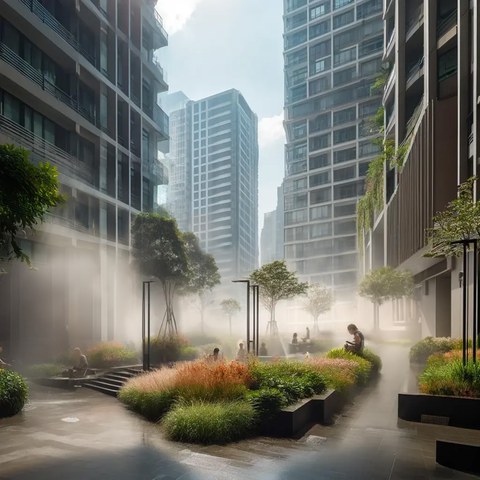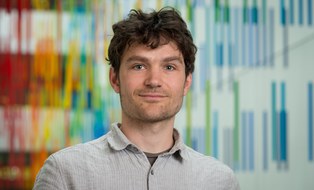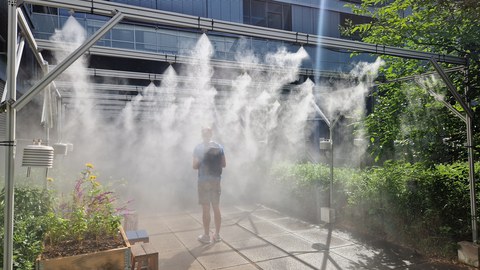Cooling potential of water-based atomization systems
Analyses of effectiveness and operating options in high-density block structures in urban areas as well as integration and utilization potential in urban digital twins

Visualisierung eines wasserbasierten Zerstäubungssystems im urbanen Umfeld, © Abbildung erstellt mit OpenAI (ChatGPT4) und nachbearbeitet.
Project description
Heat stress in cities requires increasingly high efforts to cool buildings. Rooms hardly cool down at all on tropical nights, workplaces can only be used to a limited extent and cool oases are also rare in urban open spaces. Health and economic consequences are expected to increase. Block structures as typical urban living and working environments are particularly affected. The existing courtyards hardly contribute to natural cooling due to low vegetation volumes, heat accumulation and limited nocturnal radiation. To improve the cooling potential, the use of water-based atomization systems (ZS) in courtyards is being investigated. These can be expected to reduce cooling requirements by providing pre-cooled air during the day and accelerating cooling at night. In addition, synergetic cooling oases can be created in open spaces, especially if cooling by trees (e.g. in underground car parks) is not possible. Furthermore, a reduction in the water consumption of heat-stressed vegetation can be expected. As the operation of ZS would consume additional drinking water, the treatment and storage of rainwater is being designed. It should be possible to control the use of water for evaporation in summer and for groundwater recharge in cooler months. In this way, an approximation to the natural water balance is achieved, which is often massively disturbed in cities. In the project, ZS are tested under laboratory conditions and in existing buildings and their effectiveness is recorded and evaluated using objectively measurable and subjectively perceived target values. Courtyards represent relatively closed microclimatic units with defined conditions. The use of urban digital twins enables highly scaled climate simulations; they are used both to provide data and to present and evaluate results. By linking the results, planning instructions are developed for the integration of ZS for cooling optimization in new and existing buildings.
Project news
Research funding
Zukunft Bau research funding from the Federal Institute for Research on Building, Urban Affairs and Spatial Development(project profile)
Duration
10/2024 to 01/2027
Project team
wissenschaftliche Mitarbeiterin
NameMs Michelle Jacob M.Sc.
Send encrypted email via the SecureMail portal (for TUD external users only).
Visiting address:
Hülße-Bau, Ostflügel, 5. Etage, Raum 560 Helmholtzstraße 10
01069 Dresden
Research Associate
NameMr Dipl.-Ing. Marc Anton Schwöbel
Send encrypted email via the SecureMail portal (for TUD external users only).
Chair of Hydraulic Engineering Secretariat
Visiting address:
Beyer-Bau, Raum 136 George-Bähr-Str. 1
01069 Dresden
 © Lassig
© Lassig
Scientist
NameDr. Valeri Goldberg
Send encrypted email via the SecureMail portal (for TUD external users only).
Mitarbeiterin
NameKerstin Uiboupin M.Sc.
Send encrypted email via the SecureMail portal (for TUD external users only).
 © Kirsten Lassig/TUD
© Kirsten Lassig/TUD
Wissenschaftlicher Mitarbeiter
NameBjörn Helm (Dipl.-Ing., Dipl.-Hydrol.)
Leiter der AG Siedlungshydrologie
Send encrypted email via the SecureMail portal (for TUD external users only).
Contact person
wissenschaftliche Mitarbeiterin
NameMs Michelle Jacob M.Sc.
Send encrypted email via the SecureMail portal (for TUD external users only).
Visiting address:
Hülße-Bau, Ostflügel, 5. Etage, Raum 560 Helmholtzstraße 10
01069 Dresden
 © Sven Ellger
© Sven Ellger
Professur Landschaftsbau
NameProf. Dipl.-Ing. Irene Lohaus
Studiendekanin Landschaftsarchitektur
Send encrypted email via the SecureMail portal (for TUD external users only).
Visiting address:
Hülße-Bau, Ostflügel, 5. Etage, Raum 564 Helmholtzstraße 10
01069 Dresden
Office hours:
Termine und Sprechzeiten bitte über das Sekretariat vereinbaren.

